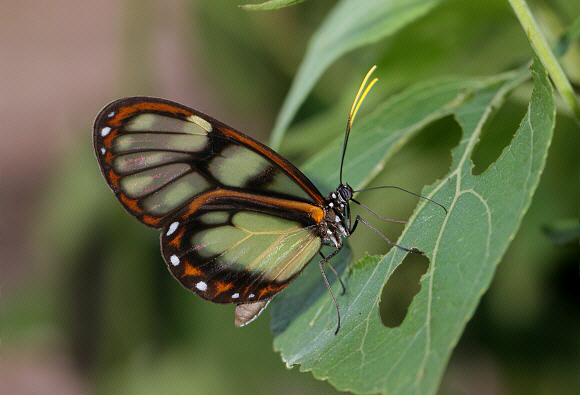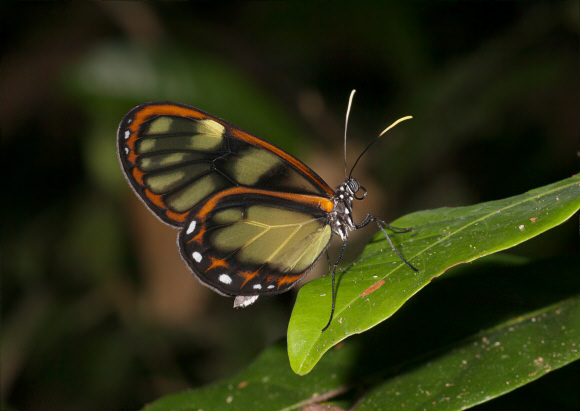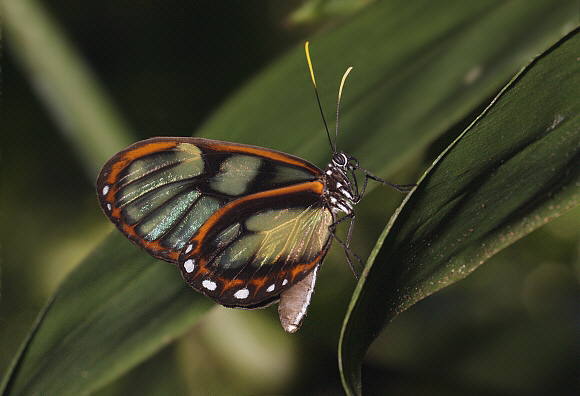
Introduction
The Ithomiini comprises of 376 known species, although it is likely that at least another 30 will be discovered in the near future. All are confined to the neotropical region. Ithomiines are unpalatable to birds, and are consequently mimicked in appearance by many other species. These include other unpalatable species ( Müllerian mimics ), not only from the Ithomiinae but also from several other butterfly families. There are also a large number of edible species ( Batesian mimics ) which have evolved similar patterns. Birds have the ability to memorise butterfly patterns and so learn to avoid eating noxious species, but are also fooled into ignoring similarly marked edible species.
Ithomiines are characterised by having small eyes, slender abdomens and long drooping antennae that lack distinct clubs. Males have a plume of long androconial scales or “hair pencils” on the costa of their hindwings. These are hidden from view when the butterflies are at rest, but are displayed when the wings are held open during courtship. Other Ithomiine characteristics include a very slow and deep wing beat, and a preference for inhabiting the darkest recesses of the forest understorey.
There are basically 2 types of Ithomiine. The first type are the black and orange-banded “tigers”, many of which are mimicked by other species due to their unpalatability to birds. The second type are the “glasswings”, recognised by their transparent or translucent wings, prominent veins, and orange wing margins. Many genera contain examples of both of these types, and in some cases an individual species may produce adults of both forms according to location.
The genus Godyris comprises 14 very attractive species, characterised by their distinctive venation.
Godyris zavaleta is the most widely distributed species in the genus, occurring from Costa Rica to southern Peru.

Habitats
This is a lowland and mid-elevation rainforest species which is found at altitudes between sea level and about 900m on the eastern slopes of the Andean foothills and Central American cordilleras.
Lifecycle
The eggs are white and laid singly on the foliage of Solanaceae. The caterpillars are naked and pale translucent green in colour, with a shiny yellow head. They feed diurnally on Solanum. The pupa is also pale translucent green, dotted with black on the wing cases, and has yellow spiracles. It is squat in shape with a strongly humped back, and suspended from the underside of leaves.

Adult behaviour
The butterfly is widespread but generally uncommon, and always encountered as singletons. It is usually seen when disturbed from rest on ferns or the foliage of sapling trees growing in light gaps in damp areas of the forest understorey. The flight is slow and fluttery, with the characteristic deep wing-beats of Ithomiines. The butterflies often visit the orchid Epidendrum panniculatum and may be important pollinators.
Males sequester pyrrolizidine alkaloids from Heliotropium, Tournefourtia, Myosotis ( Boraginaceae ), Eupatorium, Neomiranda and Senecio ( Asteraceae ). These chemicals confer toxic qualities to the butterflies which deter bird attacks. The chemicals are also used in the production of pheromones. Often the males of several Ithomiine species will gather together at communal leks, where they release these pheromones from hair-like androconial scales on the leading edge of their upperside hindwings. These attract more males, which in turn release further pheromones. After a few days the lek may include 50 or more adults comprised of as many as dozen different species. Passing females are attracted to the leks by the complex fragrances. Their presence stimulates the males to open their wings and release further pheromones that entice them into copulation. Females obtain sustenance from nectar, and also visit bird droppings which provide them with a source of nitrogen that assists with the development of their eggs.
